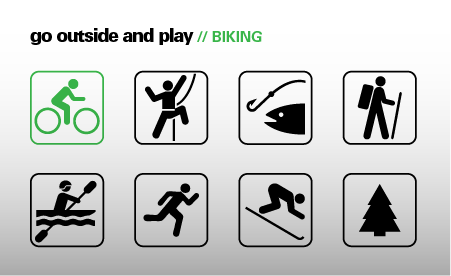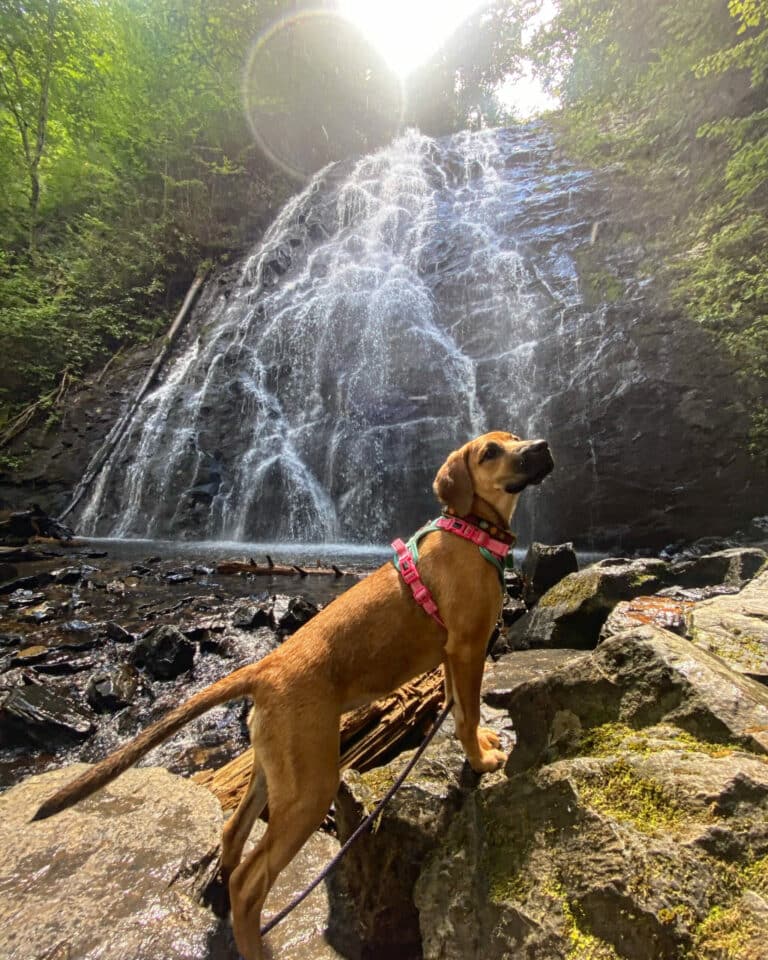<em>
“The Epic Ride designation is the golden seal of approval in mountain biking.It’s like the Oscar for Best Picture.”
</em>
My legs are on fire, my lungs are holding a coup, and my bike feels like it's made of granite and square wheels. I'm in mountain biking hell, which is strange because I’m riding one of the best trails in the Southeast. I’m sure you’ve heard that before. The “best,” “sweetest,” “gnarliest”: There’s so much buzz around some of these trail systems, it’s hard to figure out what’s reality and what’s hype. Sometimes, you have to weed through a barrage of superlatives to get to the heart of a trail. They can't all be the sweetest, right?
But the trail I’m riding really is one of the best around. Honestly. Because the International Mountain Bike Association (IMBA) says so. This is Tanasi, in eastern Tennessee, and it’s one of the IMBA “Epic Rides,” a distinction given to a select few trail systems across the globe. The “Epic Ride” is the golden seal of approval from the unofficial ruling body of all things fat tire. It is the Oscar for Best Picture. It is the Grammy for Best Album. A few new Epics are designated each year, but so far there are only 32 in the United States, and only six in the Southeast.
While you may hear hyperbole about other trails around the country, the Epic designation gives Tanasi a certain level of cache`. But that doesn’t mean I’m having a good time. At least not at first. There’s just so much climbing involved.
The elevation gain doesn’t seem to bother Doug Coulter or his other riding buddies -a couple of firemen named Jerry and Dave, and Mike Alcorn, a forest service trail engineer. Tanasi is their home track, their backyard. They’re used to paying these sort of dues. And they know what’s on the other end of this climb. If Tanasi is famous for one thing (other than the climbing), it’s the roaring downhills that await bikers who are able to make it past the initial elevation gain.
I use the word “famous” loosely. Outside of a rabidly supportive group of local riders, Tanasi is relatively unused.
“On a summer weekend, when the weather is perfect, you may have 50 riders spread out over these trails,” Coulter says. “It just doesn’t draw the crowds that Tsali draws.”
Coulter, who owns a bike shop in nearby Cleveland, Tenn., is quick to compare Tanasi with Tsali, a revered western North Carolina trail system about an hour away from Tanasi that receives the lion’s share of the region’s mountain biker activity. Tsali and Tanasi are like rival high schools on opposite ends of a small town, and Tsali is winning the popularity contest. Head to Tsali’s parking lot on any given weekend and you’ll find a sea of cars. Riders mingle on the asphalt. A vendor sells T-shirts and power gels. It’s the sort of scene you usually reserved for race weekends. The system is so popular, the Forest Service has to control traffic by enforcing an alternating trail schedule. Certain trails are open on Mondays, Wednesdays, and Fridays and others are open on Tuesdays and Thursdays and weekends.
Tanasi has no such problem. As we reach the top of our first big climb, our group stops for a water break. We haven’t seen any other riders and we won’t for the rest of the day. Nobody is sure of the exact elevation we’ve gained, but we know we’ve all been in granny gear since leaving the car. We know we’ve had to pick lines through slick roots. We know we’re happy to take a water break.
Coulter blames the climb we just finished for Tanasi’s lack of popularity. “There’s no way to access any of the trails without climbing at the beginning,” he says. “Right out of the parking lot, you’ve got to work your butt off. There’s no warm up. That climb keeps people away. It weeds people out.”
Of course he’s right. While many bikers enjoy the grind of a climb, the majority are looking for the downhills without the uphills-which helps explain Tsali’s popularity. Tsali doesn’t have any significant climbs, and it’s downhills are less technical and demanding than surrounding trail systems like Tanasi. But, as jaded as it may sound, there’s more to a trail system’s popularity than just the quality of its trails, just as there’s more to making a hit record than talented musicians. There’s public relations. There’s hype.
And if there’s any mountain bike trail system that deserves a little hype, it’s Tanasi. The 30 miles of trails start at the Ocoee Whitewater Center, and unlike most National Forest trails, these paths were built specifically for mountain biking. The elevation changes are quick and frequent, the berms are perfectly placed, and the downhills are fast, technical, and accentuated with jumps. Then there’s the location. Tanasi is two hours from Atlanta, an hour-and-a-half from Knoxville, an hour from Chattanooga, and two-and-a-half hours from Asheville. It’s in the heart of mountain bike country, sandwiched between the largest population zones in the South. And yet, Tanasi doesn’t receive the bike traffic it deserves.
This is a problem with many Epic Rides designated by IMBA. “The Epics program has waned in recent years,” says Mark Eller, manager of IMBA. IMBA still designates a few trails every year, but their involvement with the trail systems doesn’t go much further than a designation party. As a result, many of these trails, which are considered the best in the country, are completely forgotten by the biking community after the buzz from the party wears off. IMBA is hoping to change this with a little bit of hype.
“We’re hoping to get special trail markers for each Epic trail system we’ve designated, and hopefully, we’ll find regional sponsors for our clubs to provide funds for maintenance,” continues Eller.
Increasing the popularity of forgotten trail systems may seem like a minor issue, but convincing a portion of the nation’s 51 million mountain bikers to explore these under-used trail systems could be a necessity for mountain biking’s survival.
Take Bent Creek Experimental Forest, outside of Asheville, N.C. This popular fat tire destination is reaching the breaking point for mountain bike activity. The Blue Ridge Bicycle Club estimates Bent Creek sees 1,500 recreational users a week, most of which are bikers. The parking lots are consistently full, the trails are in disrepair, and the management is getting antsy. The small tract of forest land was originally designated for timber research, and David Loftis, project manager for the experimental forest, isn’t sure Bent Creek can handle the recreational activity it’s receiving. “Bent Creek is just 6,000 acres out of 150,000 acres in the Pisgah Ranger District,” he notes. “We’ve reached the upper saturation level of recreation use on the land. There is a limit to what we can do here. There’s a lot of other forest service land.”
Such as Mills River Recreation Area, a hotbed of mountain bike trails ten miles south of Bent Creek. While Mills River has trails that easily rival Bent Creek and while it is a popular fat tire destination among bikers in the know, it receives only a fraction of the regular traffic that Bent Creek receives. And don’t forget DuPont Forest, an Epic Ride only 45 minutes from Asheville that could easily accommodate more traffic.
And Bent Creek is just one tract of forest land that’s oversaturated with mountain bike activity. Tsali, while it manages existing crowds, will eventually reach a tipping point. The trails at the Chattahoochee Recreation Area in Atlanta could certainly use some relief from constant traffic. The same can be said with Cane Creek near Charlotte, or Belle Island in Richmond.
And the problem is poised to get worse. While mountain biking’s popularity waned at the turn of the century, the advent of 24-hour races and the creation of the freestyle niche have increased participation in recent years. And the popularity of mountain biking among teenagers is through the roof according to the Outdoor Industry Association. A whopping 63 percent of all mountain bikers are between the ages of 16 and 24.
Dr. Ken Cordell is a Research Project Leader for the Outdoor Recreation and Wilderness Assessment team within the National Forest system. Cordell, who was a key player in turning Tsali into the successful recreation area that we have today, isn’t sure what to do about the increase of mountain bikers on public land. “It’s amazing how much use there is, but it’s also a real management challenge. Honestly, I don’t know how we’re going to handle the increase in use overall.”
At Tanasi, the higher you climb, the better the trails get. Coulter leads our group down Thunder Rock Express. This is the headliner at Tanasi, the signature trail that some compare to heroin. It’s just as addictive. It’s fast, it’s bermy, it’s technical, it’s smooth, it’s rolling, it’s everything a mountain bike trail should be, and Coulter and a small group of riders have it all to themselves-a fact that they’d like to change.
It's not that these bikers don't appreciate the dream scenario of a “private” trail system. They're just able to see the big picture.
“The more attention these trails receive, the better they’ll be maintained,” says Mike Alcorn, the forest service trail engineer along for the ride. He’s responsible for creating new trails near the river and is also working on relieving the congestion problem at Bent Creek. “We’ll also be able to justify creating more mountain bike trails and ultimately, it will help diffuse the traffic problems we’re seeing elsewhere.”
The Epics
Tanasi
Ocoee, Tenn. 30 miles of extremely fast singletrack and doubletrack accentuated by some tough climbs, all of which rise above the Ocoee River and the Olympic Whitewater Center.
More Info: www.chattbike.com.
What to expect: A tough climb out of the gate but once you reach the top you’ll be treated with some of the best downhills in the South. Rolling and bermy: a great combination.
Must Ride: Thunder Rock Express: 1.5 miles of fast, rolling downhill. Jumps, berms, bridges, Nirvana.
Know it Alls: Scott's Bicycle Centre in Cleveland, Tenn. 423-472-9881. www.scottsbikes.com.
Detour: Shake Shack, Cleveland, Tenn. 423-476-4770. A thirty minute drive into Cleveland and you’ll be sucking down what many say is the best milk shake in the Volunteer State.
Bull Mountain
Dahlonega, Ga. More than 50 miles of trails wind up and around Bull Mountain in North Georgia. If you’re willing to do some forest road riding, you can connect to a couple of other trail heads nearby.
More info: www.sorba.org.
What to expect: The climbs aren’t terribly steep but they’re technical as hell and littered with roots and rocks. Some of the trails feel more like dried up creek beds. Bull Mountain is why God invented the full suspension bike.
Must Ride: Bull Mountain Loop: 11 miles. Easily the most popular trail in the system. It starts with a tough, technical climb and then turns into a fast, twisting downhill (read: endo-centric).
Know it Alls: Cartecay River Bicycle Shop in Ellijay, Ga. 706-635-2453.
Detour: Mack Aaron’s Apple House, Ellijay, Ga. 706-273-3180. They’ve got 11 different kinds of fried pies, which is exactly what the doctor orders after riding Bull Mountain.
Tsali
Bryson City, N.C. Forty miles of trails are split into four different loops. All consist of fast, rolling singletrack that cruises by Fontana Lake. The trails follow the contour of the mountainside as opposed to the fall line, which accounts for the roller coaster affect.
More Info: www.mtbikewnc.com
What to expect: Butter smooth trails that roll endlessly. There’s nothing too technical at Tsali, just unadulterated fat tire fun. Don’t expect to have the trails to yourself…ever.
Must Ride: Left Loop: At 12 miles, it’s the longest loop at Tsali and it offers the most lake-side riding. Lots of rolling with fast turns and a couple of good climbs followed by steep downhills. Combine it with the Right Loop for the full Epic affect.
Know it Alls: Nantahala Outdoor Center in Wesser, N.C. www.noc.com.
Detour: Aunt B’s Donut Shop in Bryson City. 828-488-0881. Fresh donuts made right in front of your eyes? What more could a biker want?
DuPont Forest
Brevard, N.C. Almost 100 miles of singletrack, doubletrack, and forest roads cruise through the 10,400 acre forest which was featured prominently in the film “Last of the Mohicans.” www.dupontforest.com.
What to expect: Dupont is famous for its eastern slickrock; big granite slabs in the middle of the trails much like Moab but without all the sand and deadly temperatures. Some of the best scenery you can imagine along a mountain bike trail: several trails take you to the base of impressive waterfalls. You’ll have to use fire roads to connect some of the singletrack but it’s worth it.
Must Ride: Cedar Rock: 1.5 miles of the eastern slickrock that everyone loves. It’s rocky, technical, and you can combine it with a handful of other similar trails for a day-long adventure.
Know it Alls: Backcountry Outdoors in Brevard, N.C. 828-884-4262
Detour: Hawg Wild Barbecue, Pisgah, N.C. 828-877-4404. Do you really need a reason to check this place out or is the name enticing enough?
The Southern Traverse:
Harrisonburg, Va. 32 miles of beastly singletrack through a historic Civil War battle field. And 3,000 feet of elevation gain in the George Washington National Forest.
More Info: www.mtntouring.com.
What to expect: Lots of ridge riding on this tight, winding singletrack littered with fast downhills and technical rock gardens.
Must ride: Shenandoah Mountain Trail: This 17-mile trail is the backbone of the Southern Traverse. Most people ride it from North to South in order to climb the forest roads and descend the singletrack. A shuttle is almost mandatory. Know it Alls: The Shenandoah Bicycle Company in Harrisonburg, Va. 540-437-9000.
Detour: Dave’s Downtown Taverna, Harrisonburg, Va. 540-564-1487. $2 Natural Light pitchers. You can’t beat that.
Gauley Headwaters:
Slatyfork, W.Va. Rocks, hills, rocks, hills, and rocky hills dominate the 37-miles of trails within the Cranberry Wilderness. This is classic gnarly West Virginia singletrack and possibly the toughest in the east.
More Info: www.wvmba.com.
What to expect: From expansive meadows to deep hardwood forests, the scenery is breathtaking, but so are the trails. Finish ten miles of the Gauley Headwaters and you’ll feel like you actually accomplished something with your life-a rare feeling for a day of mountain biking.
Must ride: Tea Creek Mountain Trail: 4.5 miles of rocks and roots. The climb at the beginning is a beast (there’s no shame in walking) but you’re rewarded with a three mile downhill that’s tight, narrow, and fast.
Know it Alls: Elk River Touring Center in Slatyfork, W.Va. www.ertc.com.
Detour: Forget the restaurants. Pack a lunch and head to Snowshoe for some lift-served downhill riding and mountain bike park fun. You’ve earned it. www.ride.snowshoemtn.com.








